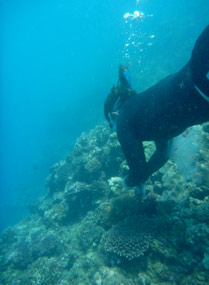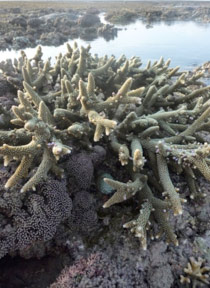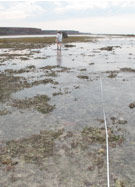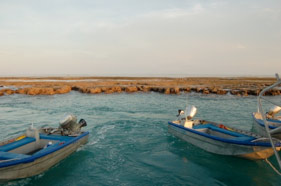Researchers' Diaries
Dr. Zoe Richards
Australian Museum
Kimberley Coastal Corals – Cassini Island/Long Reef 2010
The latest Kimberley Marine Life expedition has confirmed that the pristine status of the Kimberley is definitely reflected below the surface. This year our marine biodiversity research team surveyed Long reef and Cassini Island in the eastern Kimberley. Focussing on the hard coral biodiversity, I was geared up to describe the distribution and abundance of corals in these locations using the same methods as used previously at Montgomery Reef and Adele Island. I also collected a comprehensive skeletal and molecular collection of the corals, which will be used to support wider projects.
Surveying Cassini Island first, I was to discover that despite being a relatively small Island, Cassini is surrounded by a surprising variety of coral reef habitats. The reef types vary from atoll-like lagoonal habitat with isolated coral bommies to steep reef fronts with strong channelling and extensive intertidal flats supporting well developed coral, seagrass and macro-algal communities (hence Cassini Island is also a lively turtle breeding habitat). The water was surprisingly clear at some sites, including the NE corner, where I recorded 90 species of hard coral within a single depth zone (4 x 15m belt transects – 12m depth). Given the relatively small area surveyed (60m2), this level of diversity is exceptional and far higher than recorded at any of the other 10 sites I surveyed at this depth (at those sites diversity ranged from 34-71 species).
At nearby Long Reef, the water visibility was considerably worse than Cassini Island because it is directly in the path of outflow from King George Sound. However, one stand-out feature of Long Reef was the discovery of a unique habitat zone on the eastern side of the reef dominated by Organ Pipe Coral (Tubipora sp). From point-intercept transects conducted in this habitat zone, I calculated a mean of 27% cover of Tubipora. This level of coverage seems to be exceptionally rare for Organ Pipe coral. Long reef is visually spectacular at low tide, bearing resemblance to the cascades of Montgomery Reef, although at Long Reef the cascades are lower in profile.
Some of the skeletal samples collected on this trip are in need of further investigation, however the preliminary data suggests approximately 230 species of hard coral are present at Cassini Island and Long Reef, with Cassini Island having approximately 30 more species than Long Reef. This level of hard coral diversity is substantially higher than recorded previously at Montgomery Reef and Adele Island. One particularly exciting finding on this latest expedition was of Madracis kirbyi, which I have never personally seen underwater and this species now joins a growing list of new records whose ranges can now be extended to include the Kimberley.
Overall, the most outstanding feature of the Kimberley corals is their health. Despite their routine exposure to extreme temperatures and exposure from ultra violet light, cyclonic activity, and propensity for high levels of turbidity, the corals are exceptionally healthy with few visible signs of stress response or disease observed. A small number of crown-of-thorns starfish were recorded and there were no outbreaks of predatory molluscs or evidence of any recent coral bleaching. The well-developed reefs of the Kimberley are of global significance and provide an unparalleled opportunity to examine coral reef communities in the absence of human impact.

- Dr Zoe Richards free-diving to collect samples from Acropora tenuis on the reef crest at Cassini Island.
- Photo by Phil Tucak
- Image copyright of WA Museum

- Acropora aspera conceals a colony of Tubipora sp. while exposed at low tide at Long Reef.
- Photo by Phil Tucak
- Image copyright of WA Museum

- Dr Zoe Richards lays one of the transects on the intertidal reef flat along which she recorded the abundance and diversity of coral species.
- Photo by Clay Bryce
- Image copyright of WA Museum

- Spring tide at Long reef exposes the enormous reef, which slopes steeply to 20m enabling unparalleled vessel access.
- Photo by Phil Tucak
- Image copyright of WA Museum








